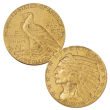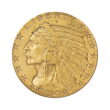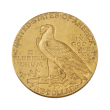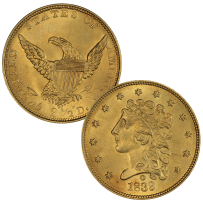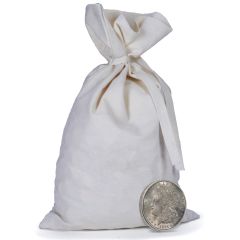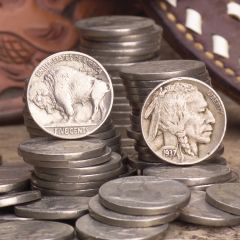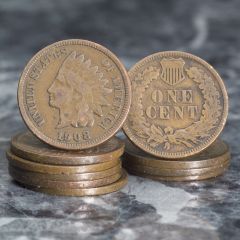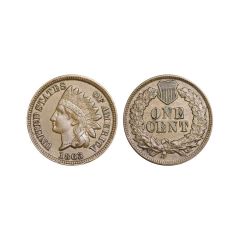$2.5 Gold Indian - XF-AU Condition
The $2.5 Indian Head Quarter Eagle (1908-1929) features Bela Lyon Pratt’s distinctive incuse design with a Native American headdress-wearing Liberty and standing eagle. Minted in Denver and Philadelphia, this 0.12094 troy ounce gold coin shares its artistic motif with the $5 version. Pratt created unique smaller designs when the Saint-Gaudens Double Eagle pattern proved impractical for smaller denominations. The coin’s recessed relief design and limited production make it a numismatic standout. These technical and artistic innovations during America’s coinage renaissance established the Indian Head Quarter Eagle as both a collector’s favorite and an important piece of U.S. monetary history.
The United States Mint began producing gold coins in 1795 with the $10 Liberty Eagle Coin, following the Coinage Act of 1792. Over time, designs evolved to include the Liberty Head Gold Eagle, Indian Head Gold Eagle, and the celebrated Saint-Gaudens Double Eagle—introduced in 1850 during the California Gold Rush. These pre-1933 gold coins, ranging from $1 Liberty Heads to $20 Double Eagles, remain among the most historically significant and artistically admired in numismatic history.
In the early 1900s, President Theodore Roosevelt championed a redesign of U.S. coinage, commissioning sculptor Augustus Saint-Gaudens to create more artistic designs. The resulting Saint-Gaudens Double Eagle (1907–1933) became one of the most beautiful coins ever minted, later inspiring the 1986 Gold Eagle. However, in 1933, President Franklin Roosevelt issued Executive Order 6102, criminalizing private gold ownership to combat economic hoarding during the Great Depression. Most circulating gold coins were surrendered and melted, with rare exceptions for collectibles. The subsequent Gold Reserve Act of 1934 transferred Federal Reserve gold to the Treasury and raised its price from $20.67 to $35 per ounce, stabilizing inflation and effectively ending the gold standard.
Today, pre-1933 U.S. gold coins are prized rarities, having survived government recall. They represent both artistic achievement and a pivotal era in American monetary history, preserving a tangible connection to the nation’s past.
| Quantity | 1 |
|---|---|
| Description | The United States Mint began producing gold coins in 1795 with the $10 Liberty Eagle Coin, following the Coinage Act of 1792. Over time, designs evolved to include the Liberty Head Gold Eagle, Indian Head Gold Eagle, and the celebrated Saint-Gaudens Double Eagle—introduced in 1850 during the California Gold Rush. These pre-1933 gold coins, ranging from $1 Liberty Heads to $20 Double Eagles, remain among the most historically significant and artistically admired in numismatic history. In the early 1900s, President Theodore Roosevelt championed a redesign of U.S. coinage, commissioning sculptor Augustus Saint-Gaudens to create more artistic designs. The resulting Saint-Gaudens Double Eagle (1907–1933) became one of the most beautiful coins ever minted, later inspiring the 1986 Gold Eagle. However, in 1933, President Franklin Roosevelt issued Executive Order 6102, criminalizing private gold ownership to combat economic hoarding during the Great Depression. Most circulating gold coins were surrendered and melted, with rare exceptions for collectibles. The subsequent Gold Reserve Act of 1934 transferred Federal Reserve gold to the Treasury and raised its price from $20.67 to $35 per ounce, stabilizing inflation and effectively ending the gold standard. Today, pre-1933 U.S. gold coins are prized rarities, having survived government recall. They represent both artistic achievement and a pivotal era in American monetary history, preserving a tangible connection to the nation’s past. |
We're confident you will be satisfied with your purchase, but if not, you may return your item for a refund or exchange within 30 days of invoice date. Shipping and handling charges are non-refundable, and the product must be returned complete and in sellable condition to qualify for a refund. Refund amount will include full purchase price and all collected taxes.Seals and cases contribute to the value of coin and currency collectibles and must remain intact and unbroken. This applies, but is not limited to: grading cases, Mint and Proof cases and packages, bag seals, original government sealed packaging, certificates of authenticity and/or any other special packaging or containers. Customers are responsible for shipping charges and risk of loss on all return shipments. All returns must be shipped by a reputable shipper and be properly packaged and fully insured. Products returned after 30 days of shipping date are subject to a 20% restocking fee.

